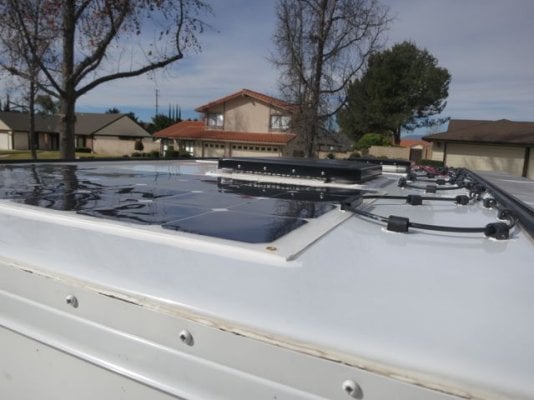Here is a summary of the parts and install process I used – a few pictures are upthread. If you piece the info together from other threads there probably isn’t anything new here, but maybe it puts much of it into one location. For many this is probably no big deal and you have already done a solar install and it was so obvious and simple. But this was a big deal for me and I had no knowledge of the technology, parts, or process before I started, so this is for all the noobs like me out there, hopefully this helps someone.
I was originally thinking of fabricating aluminum platforms for the bendable solar panels and attaching those to my Yakima tracks. But I didn’t realize how heavy the aluminum platforms would be, and Renogy confirmed that air circulation is not really needed under the panels - they said many of their customers glue them down. I’m really glad I went this route because it resulted in a very light, simple and clean install, and much more aerodynamic than if they were on raised panels.
My starting point
2012 Fleet with FWC installed 85W (?) panel (22 lbs) and Morningstar Sunsaver 6 solar controller. So all the in camper solar wiring was already done by FWC. I just needed to upgrade my controller to match the panels.
Here are the parts/supplies I used to install three 100W Renogy bendable panels wired in parallel
- Three Renogy 100W panels (4 lbs each)
- Two packages of MC4 connectors. One package is all you need as long as you don’t make any mistakes, which I did and needed to order another package
- Four Renogy branch connectors (2 packages)
- Renogy 9” adaptors
- 20’ of Renogy 12 gauge cable
- Three tubes of 3M Marine 4000UV adhesive to glue panels
- SAE plug – received at no cost from FWC!
- A few packs of large and small D Wings from Home Depot to hold solar wire off camper roof. Thanks to Sledawg for this suggestion.
- Bricks from Home Depot (returned after install…)
- I also had to upgrade my Morningstar Sunsaver 6 to a Sunsaver 20L to handle the increased load. This had the same footprint as the Sunsaver6 so nothing special was required to install.
- In-line 25 amp blade fuse
- Two 25 amp blade fuses
Installation on the roof - Although it took many hours of reading to figure this out, the install is actually quite simple:
- Remove the original panel and fill the six holes with silicone
- Wash the entire roof with soap and water
- Clean the areas where the panels and wiring will be glued down with Acetone
- Lay the panels in place and figure out the simplest pattern for all the wiring following really helpful Renogy videos for how to wire in parallel
- Fine-tune the location of panels as needed so wiring plan works and wires don’t come out of the panels at tight angles – then put tape at the corner of each panel to aid in re-location when you glue them down
- Apply glue to each panel– following Jim’s advice, I used about ½” bead, ½ inch from the edge around the perimeter , plus some in the middle.
- Carefully lay the panel in place based on your tape markings. This is the only step that you need a second person to help. I used a towel to press the edges down and in the middle of the panel where there was also adhesive (plastic covering still on face of panels)
- Lay the foam inserts that came with the panels on top of the panel and then put bricks on top of the foam. The bricks I used weighed 100 lbs per panel. Terry told me that the roof will hold 1000 lbs, so the 300 lbs total for 24 hours was not a problem.
- Wire everything up as neatly as possible with the D wings and zip ties to keep the wiring from touching the roof.
- Caulk around edge of each panel. Probably not needed, but it is a nice finishing touch.
Installation inside the camper - I’m sure this is different for every camper, depending on what you are starting with
- Install Morningstar Sunsaver 20L – this was an easy swap-out since it was the same footprint as the Sunsaver 6.
- For my install Terry told me I needed to add a new in-line fuse…(I'll get a picture of this over the weekend)
- Upgrade the two battery cable fuses from 10 amps to 25 amps
Plug it in!
- Remove the bricks, foam and clear plastic from each panel
- Clear a perimeter of 100’ around your truck (haha)… close your eyes, and plug it in! It’s pretty anti climatic because nothing happens, it just starts quietly working. Amazing, 300W of solar machine.
The entire install process took about 4 hours with the help of my son, Paul.
Bottom line, given that you need to buy all the odds and ends whether you install 200W or 300W, it seems worth it to just go to 300W if you have a compressor fridge. This gives you a buffer for those winter days with low sun angle, or stormy summer days where you need to get as much solar input as quickly as possible when the sun does come out.
Thanks to RC Pilot Jim, DrJ, and others for threads about their installs. I had several emails and calls with Renogy and Morningstar – both very responsive companies providing personal support. A special thanks to Brenda at FWC – there was a week or two where I’m sure she was afraid to open her email knowing that there was probably another question from me – she is a saint! Terry helped with my last question about a new in-line fuse that needed to be added.




